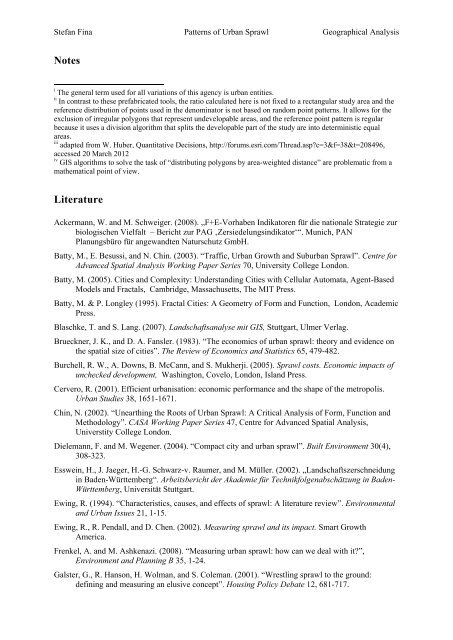PDF 20.134kB - TOBIAS-lib - Universität Tübingen
PDF 20.134kB - TOBIAS-lib - Universität Tübingen
PDF 20.134kB - TOBIAS-lib - Universität Tübingen
Sie wollen auch ein ePaper? Erhöhen Sie die Reichweite Ihrer Titel.
YUMPU macht aus Druck-PDFs automatisch weboptimierte ePaper, die Google liebt.
Stefan Fina Patterns of Urban Sprawl Geographical Analysis<br />
Notes<br />
i<br />
The general term used for all variations of this agency is urban entities.<br />
ii<br />
In contrast to these prefabricated tools, the ratio calculated here is not fixed to a rectangular study area and the<br />
reference distribution of points used in the denominator is not based on random point patterns. It allows for the<br />
exclusion of irregular polygons that represent undevelopable areas, and the reference point pattern is regular<br />
because it uses a division algorithm that splits the developable part of the study are into deterministic equal<br />
areas.<br />
iii<br />
adapted from W. Huber, Quantitative Decisions, http://forums.esri.com/Thread.asp?c=3&f=38&t=208496,<br />
accessed 20 March 2012<br />
iv<br />
GIS algorithms to solve the task of “distributing polygons by area-weighted distance” are problematic from a<br />
mathematical point of view.<br />
Literature<br />
Ackermann, W. and M. Schweiger. (2008). „F+E-Vorhaben Indikatoren für die nationale Strategie zur<br />
biologischen Vielfalt – Bericht zur PAG ‚Zersiedelungsindikator‘“. Munich, PAN<br />
Planungsbüro für angewandten Naturschutz GmbH.<br />
Batty, M., E. Besussi, and N. Chin. (2003). “Traffic, Urban Growth and Suburban Sprawl”. Centre for<br />
Advanced Spatial Analysis Working Paper Series 70, University College London.<br />
Batty, M. (2005). Cities and Complexity: Understanding Cities with Cellular Automata, Agent-Based<br />
Models and Fractals, Cambridge, Massachusetts, The MIT Press.<br />
Batty, M. & P. Longley (1995). Fractal Cities: A Geometry of Form and Function, London, Academic<br />
Press.<br />
Blaschke, T. and S. Lang. (2007). Landschaftsanalyse mit GIS, Stuttgart, Ulmer Verlag.<br />
Brueckner, J. K., and D. A. Fansler. (1983). “The economics of urban sprawl: theory and evidence on<br />
the spatial size of cities”. The Review of Economics and Statistics 65, 479-482.<br />
Burchell, R. W., A. Downs, B. McCann, and S. Mukherji. (2005). Sprawl costs. Economic impacts of<br />
unchecked development, Washington, Covelo, London, Island Press.<br />
Cervero, R. (2001). Efficient urbanisation: economic performance and the shape of the metropolis.<br />
Urban Studies 38, 1651-1671.<br />
Chin, N. (2002). “Unearthing the Roots of Urban Sprawl: A Critical Analysis of Form, Function and<br />
Methodology”. CASA Working Paper Series 47, Centre for Advanced Spatial Analysis,<br />
Universtity College London.<br />
Dielemann, F. and M. Wegener. (2004). “Compact city and urban sprawl”. Built Environment 30(4),<br />
308-323.<br />
Esswein, H., J. Jaeger, H.-G. Schwarz-v. Raumer, and M. Müller. (2002). „Landschaftszerschneidung<br />
in Baden-Württemberg“. Arbeitsbericht der Akademie für Technikfolgenabschätzung in Baden-<br />
Württemberg, <strong>Universität</strong> Stuttgart.<br />
Ewing, R. (1994). “Characteristics, causes, and effects of sprawl: A literature review”. Environmental<br />
and Urban Issues 21, 1-15.<br />
Ewing, R., R. Pendall, and D. Chen. (2002). Measuring sprawl and its impact. Smart Growth<br />
America.<br />
Frenkel, A. and M. Ashkenazi. (2008). “Measuring urban sprawl: how can we deal with it?”,<br />
Environment and Planning B 35, 1-24.<br />
Galster, G., R. Hanson, H. Wolman, and S. Coleman. (2001). “Wrestling sprawl to the ground:<br />
defining and measuring an elusive concept”. Housing Policy Debate 12, 681-717.

















